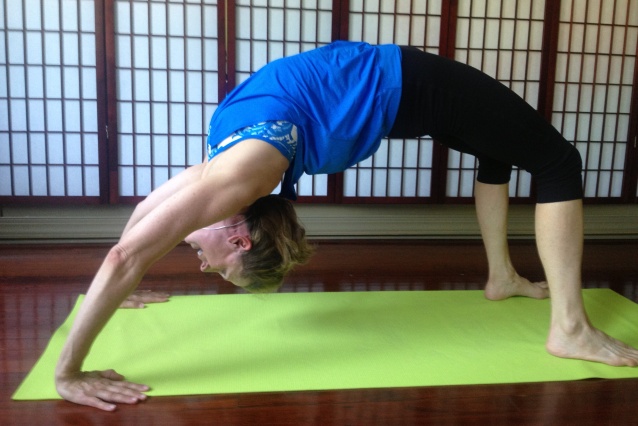Urdhva means upwardfacing and Dhanurasana means bow. That would make this pose Upward Facing Bow Pose. However, it is more commonly called Wheel (even though the Sanskrit word for wheel is Chakra – go figure). Regardless of what we call this pose, it is a big back bend.
To prepare for Urdhva Dhanurasana we need to open our shoulders, upper back, front of the hips and front of the thighs. If these parts of the body aren’t open enough, we might feel pain in our low backs, wrists or neck. The hips and shoulders are the most moveable parts of the body. But, if they don't have their optimum range of movement, then the wrists, elbows, neck, knees, ankles and low back can take the strain because they are often asked to move more than they should.
Often students will ask me how they can stretch their wrists because that’s where they feel the most pain when they do Wheel. Often the site of the pain is not the cause of the pain and this is true with the wrists in Wheel. If you are feeling pain in your wrists during Wheel, or other poses where the hands are part of the foundation, the reason for the pain is most likely because of restricted movement in your shoulders.
This month, we will explore opening your shoulders, and hips as we work on Wheel. You’ll learn to recognize where you are stuck and where you should spend some time in your home practice to improve your ability to do Urdhva Dhanurasana.
Here are some exercises to do for your yoga homework to improve your Wheel.
Are your shoulders tight? Do your wrists hurt when you do Wheel?
Set up for Wheel with your head and forearms touching the wall. When you come up into Wheel this way, it gives you a sense of direction. The idea is to move your chest towards the wall. If your chest is far from the wall, then your wrists will be bent at an acute angle. (Your wrists are not meant to be bent at an angle less than 90 degrees!) Have someone take a picture of you in Wheel and see how far your chest is away from the wall. When you look at a picture of yourself in Wheel, you should look more like an upside down "U", and less like an arc of a circle. If your chest is far from the wall and you look more like an arc of a circle, then you need to do some stretches to open up your shoulders.
To improve the flexibility in your shoulders do this stretch everyday:
Cow Face Arms. Extend your right arm straight up to the ceiling. Bend your elbow and pat yourself on your back with your right hand, dropping it down behind you from above. Take your left arm and swing it up behind your back, trying to reach your top hand with your bottom hand. If you cannot connect your fingers together, dangle a belt down from the top hand and grab it with the bottom hand. Do this three times on each side, holding for 10 to 20 seconds each time.
Cow Face Arms with a belt. If your shoulders aren't open enough for Wheel - you will probably need a belt to do this pose.
Are your hips tight? Can you keep your heels on the floor in Wheel?
To improve the flexibility in your hips do this stretcheveryday:
Thigh stretch at the wall. Slide your left shin up the wall and bring your right foot forward into a lunge position. Can you get your left knee to the wall with your hips level? Make sure that your knee is behind your hip and straight down, not in front of your hip and slanting out to the side. Do this every day, three times each side, holding for 20 to 30 seconds at most on each side.
Pigeon Thigh Stretch at the Wall. If this is hard to do and be in good alignment, then your hip flexors are probably hard for you to keep your heels down in Wheel.
It would be nice to take a "before" picture at the beginning of the month and an "after" picture at the end to chart our progress. What do you think? Are you in?






